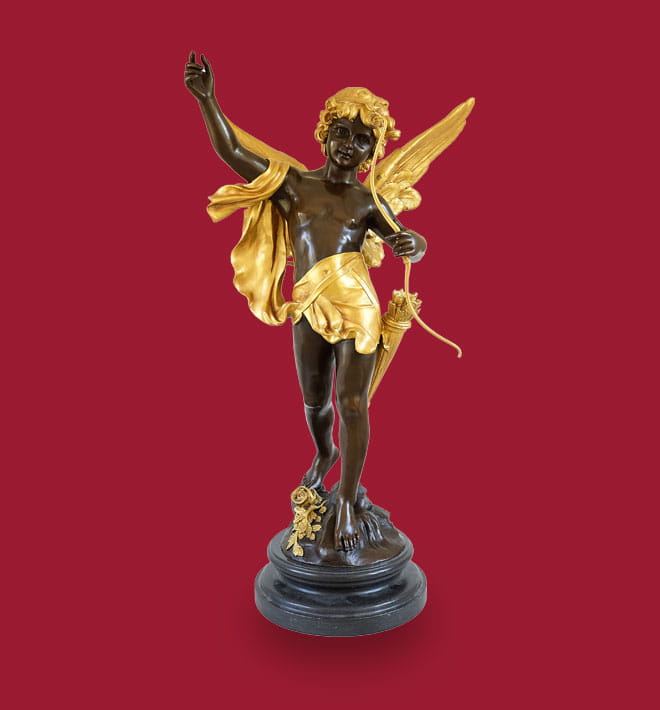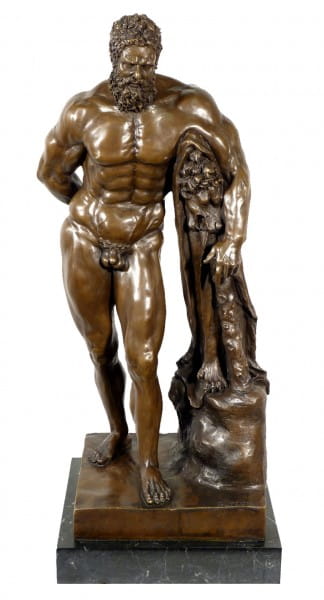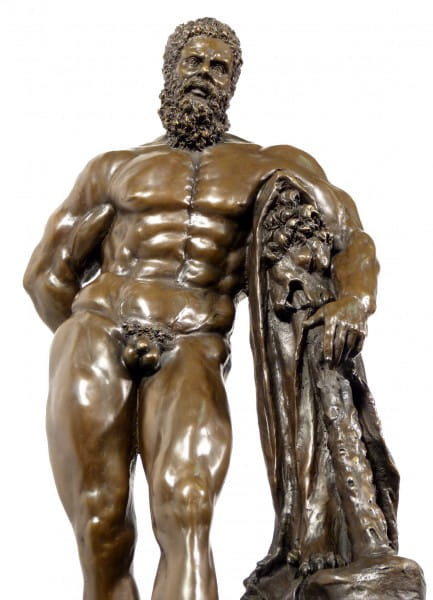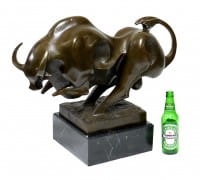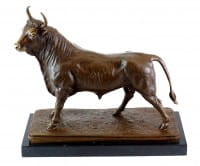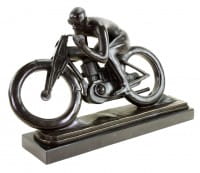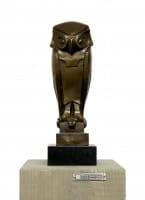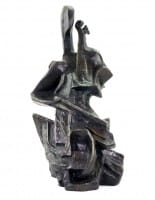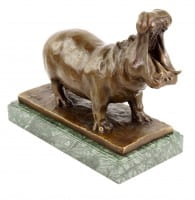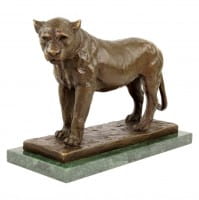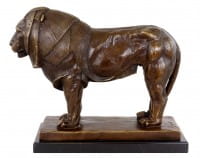€2,499.00 *
Prices incl. VAT, free shipping worldwide
Ready to ship today,
Delivery time appr. 3-6 workdays










The Farnese Hercules – A Monumental Bronze Masterpiece - Signed Glycon The Farnese Hercules... more
Product description
"Farnese Hercules - Hercules Statue - Greek Statue "
| Weight | 19,8 kg |
The Farnese Hercules – A Monumental Bronze Masterpiece - Signed Glycon
The Farnese Hercules is among the most celebrated sculptures in human history — a monumental depiction of strength tempered by exhaustion, heroism entwined with humanity. In this Hercules Statue, the demigod stands tall and powerful, resting his weight on a club draped with the skin of the Nemean lion, a trophy from his first labor. His muscular body is rendered with extraordinary anatomical precision, every sinew and tendon speaking of the struggles he has endured. Yet, his bowed head and contemplative expression reveal a deeper layer — that even the mightiest must pause and reflect. This Greek Statue embodies the perfect union of divine power and mortal emotion, a theme that has resonated through centuries of sculptural history.
The Legacy of Glycon of Athens
This masterpiece bears the signature of Glycon, an accomplished sculptor of the Roman Imperial period who is believed to have worked in Athens during the 3rd century AD. Although little is known about his family or early training, scholars believe Glycon was deeply influenced by the Hellenistic masters and may have studied in workshops that traced their lineage to Lysippos, the personal sculptor of Alexander the Great. His version of the Hercules Statue, known as the Farnese Hercules, is considered the most complete and masterful interpretation of the ancient hero. Glycon’s genius lay in transforming a classical myth into a study of psychological depth — not the invincible warrior in battle, but the weary man who bears the weight of his triumphs. The enduring power of this Hercules Sculpture lies precisely in that balance between divinity and vulnerability.
The Birth of a Timeless Icon
The original Farnese Hercules was discovered in the early 16th century in the Baths of Caracalla in Rome and was quickly recognized as one of antiquity’s greatest treasures. Scholars and artists of the Renaissance, including Michelangelo and Rubens, admired its monumental presence and emotional intensity. The composition is based on a lost bronze created by Lysippos around the 4th century BC, later copied in marble by Glycon for a Roman patron. In the bronze edition seen here, the sculptural vitality of the piece is fully restored — the gleaming metal surface capturing the vitality of living flesh and the grandeur of eternal form. The Greek Statue radiates both motion and stillness, its surface alive with the echoes of ancient craftsmanship.
The Symbolism of the Hero
In this Hercules Sculpture, the hero is depicted in the moment after completing his Twelve Labors, holding in his right hand the golden apples of the Hesperides — his final triumph. The lion’s pelt that drapes his arm is not only a symbol of conquest but also a reminder of the beast within, conquered through endurance and will. His stance conveys a rhythm of tension and release: the powerful torso balanced on relaxed legs, the downward gaze suggesting introspection rather than pride. This deliberate contrast transforms the Hercules Statue into a philosophical meditation on strength, courage, and the burden of greatness. It tells us that heroism is not only found in the act of victory but in the humility that follows it.
The Technical Mastery of the Bronze
The brilliance of Glycon’s craftsmanship is revealed in every detail of this Greek Statue. The lost-wax casting technique allows for exquisite definition, from the rough texture of the lion’s mane to the smooth sheen of Hercules’ skin. The patina is rich and warm, evoking the living glow of human flesh, while the solid marble base grounds the figure in a dignified stillness. The sense of realism is heightened by the perfect proportions and lifelike presence of the hero’s anatomy — monumental, yet unmistakably human. Each surface reflects the sculptor’s understanding of how bronze captures both light and emotion, turning myth into living substance. This is not simply a Hercules Sculpture, but a study in the eternal language of the human form.
The Influence and Modern Presence
Today, the original Farnese Hercules by Glycon stands proudly in the Museo Archeologico Nazionale in Naples, where it continues to inspire artists, historians, and admirers from around the world. Casts and bronze editions, such as this one, can also be found in prestigious collections and museums in London, Paris, and Berlin. The image of Hercules resting has become one of the most enduring symbols of classical strength and philosophical reflection, transcending time and culture. To possess such a Greek Statue is to hold a piece of human history — a reminder of the ideals that shaped civilization itself. The timeless beauty of this bronze continues to define the very essence of heroic sculpture.
The Eternal Strength of Hercules
This magnificent Hercules Statue, signed by Glycon, stands not only as a tribute to the legendary hero but as a monument to the resilience of the human spirit. The sculptor’s mastery transforms myth into emotion, marble into bronze, and legend into lasting presence. Every curve of muscle and shadow of form speaks of endurance, reflection, and inner power. The Farnese Hercules remains one of the most profound representations of man’s pursuit of greatness and the quiet dignity found in repose.
The Farnese Hercules is among the most celebrated sculptures in human history — a monumental depiction of strength tempered by exhaustion, heroism entwined with humanity. In this Hercules Statue, the demigod stands tall and powerful, resting his weight on a club draped with the skin of the Nemean lion, a trophy from his first labor. His muscular body is rendered with extraordinary anatomical precision, every sinew and tendon speaking of the struggles he has endured. Yet, his bowed head and contemplative expression reveal a deeper layer — that even the mightiest must pause and reflect. This Greek Statue embodies the perfect union of divine power and mortal emotion, a theme that has resonated through centuries of sculptural history.
The Legacy of Glycon of Athens
This masterpiece bears the signature of Glycon, an accomplished sculptor of the Roman Imperial period who is believed to have worked in Athens during the 3rd century AD. Although little is known about his family or early training, scholars believe Glycon was deeply influenced by the Hellenistic masters and may have studied in workshops that traced their lineage to Lysippos, the personal sculptor of Alexander the Great. His version of the Hercules Statue, known as the Farnese Hercules, is considered the most complete and masterful interpretation of the ancient hero. Glycon’s genius lay in transforming a classical myth into a study of psychological depth — not the invincible warrior in battle, but the weary man who bears the weight of his triumphs. The enduring power of this Hercules Sculpture lies precisely in that balance between divinity and vulnerability.
The Birth of a Timeless Icon
The original Farnese Hercules was discovered in the early 16th century in the Baths of Caracalla in Rome and was quickly recognized as one of antiquity’s greatest treasures. Scholars and artists of the Renaissance, including Michelangelo and Rubens, admired its monumental presence and emotional intensity. The composition is based on a lost bronze created by Lysippos around the 4th century BC, later copied in marble by Glycon for a Roman patron. In the bronze edition seen here, the sculptural vitality of the piece is fully restored — the gleaming metal surface capturing the vitality of living flesh and the grandeur of eternal form. The Greek Statue radiates both motion and stillness, its surface alive with the echoes of ancient craftsmanship.
The Symbolism of the Hero
In this Hercules Sculpture, the hero is depicted in the moment after completing his Twelve Labors, holding in his right hand the golden apples of the Hesperides — his final triumph. The lion’s pelt that drapes his arm is not only a symbol of conquest but also a reminder of the beast within, conquered through endurance and will. His stance conveys a rhythm of tension and release: the powerful torso balanced on relaxed legs, the downward gaze suggesting introspection rather than pride. This deliberate contrast transforms the Hercules Statue into a philosophical meditation on strength, courage, and the burden of greatness. It tells us that heroism is not only found in the act of victory but in the humility that follows it.
The Technical Mastery of the Bronze
The brilliance of Glycon’s craftsmanship is revealed in every detail of this Greek Statue. The lost-wax casting technique allows for exquisite definition, from the rough texture of the lion’s mane to the smooth sheen of Hercules’ skin. The patina is rich and warm, evoking the living glow of human flesh, while the solid marble base grounds the figure in a dignified stillness. The sense of realism is heightened by the perfect proportions and lifelike presence of the hero’s anatomy — monumental, yet unmistakably human. Each surface reflects the sculptor’s understanding of how bronze captures both light and emotion, turning myth into living substance. This is not simply a Hercules Sculpture, but a study in the eternal language of the human form.
The Influence and Modern Presence
Today, the original Farnese Hercules by Glycon stands proudly in the Museo Archeologico Nazionale in Naples, where it continues to inspire artists, historians, and admirers from around the world. Casts and bronze editions, such as this one, can also be found in prestigious collections and museums in London, Paris, and Berlin. The image of Hercules resting has become one of the most enduring symbols of classical strength and philosophical reflection, transcending time and culture. To possess such a Greek Statue is to hold a piece of human history — a reminder of the ideals that shaped civilization itself. The timeless beauty of this bronze continues to define the very essence of heroic sculpture.
The Eternal Strength of Hercules
This magnificent Hercules Statue, signed by Glycon, stands not only as a tribute to the legendary hero but as a monument to the resilience of the human spirit. The sculptor’s mastery transforms myth into emotion, marble into bronze, and legend into lasting presence. Every curve of muscle and shadow of form speaks of endurance, reflection, and inner power. The Farnese Hercules remains one of the most profound representations of man’s pursuit of greatness and the quiet dignity found in repose.
Width: 25 cm
Height: 62 cm
Depth: 23 cm
Weight: 19,8 kg
100% Bronze
Related links to "Farnese Hercules - Hercules Statue - Greek Statue"
Read, write and discuss reviews... more
Customer evaluation for "Farnese Hercules - Hercules Statue - Greek Statue"
Write an evaluation
Evaluations will be activated after verification.
Our advantages
free shipping
Worldwide free shipping
14 days money back
You can cancel your order
within 14 days
secure payment services
Paypal, Master Card, Visa, American Express and more
NEW
NEW
NEW
NEW

